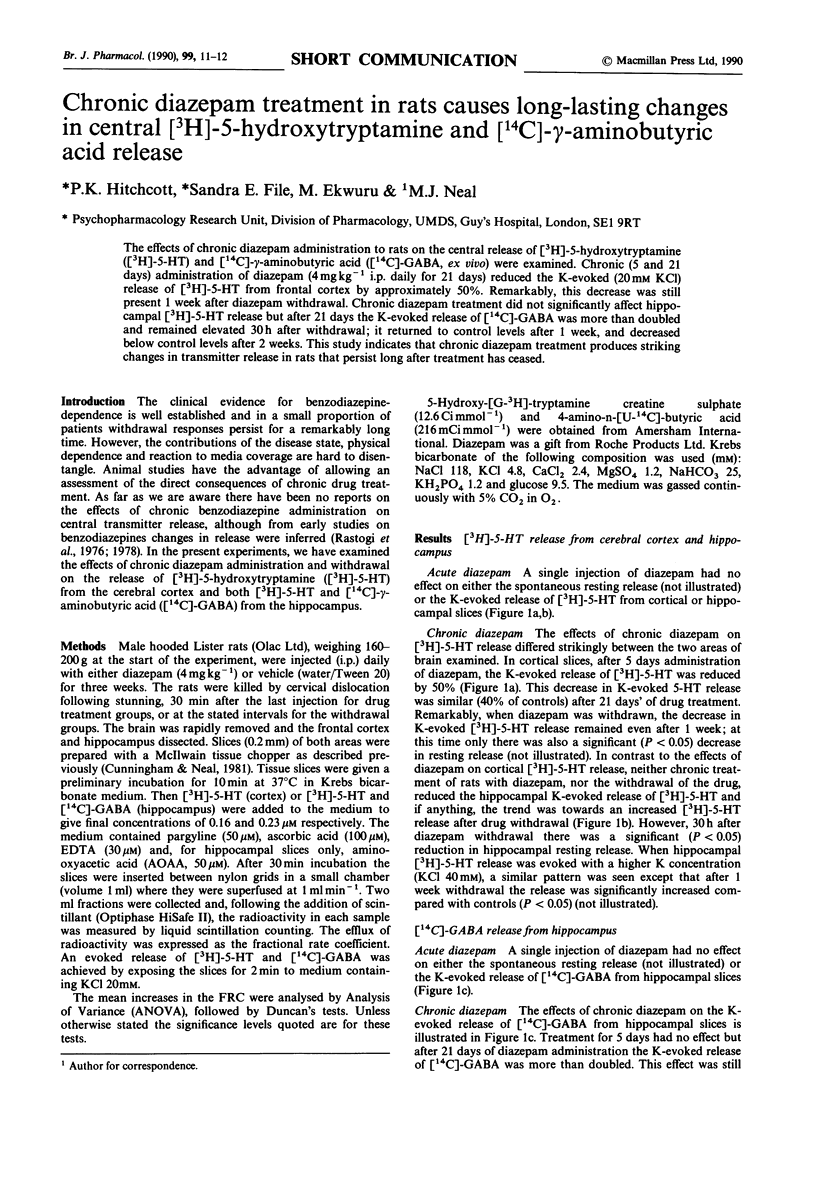Abstract
The effects of chronic diazepam administration to rats on the central release of [3H]-5-hydroxytryptamine ([3H]-5-HT) and [14C]-gamma-aminobutyric acid ([14C]-GABA, ex vivo) were examined. Chronic (5 and 21 days) administration of diazepam (4 mg kg-1 i.p. daily for 21 days) reduced the K-evoked (20 mM KCl) release of [3H]-5-HT from frontal cortex by approximately 50%. Remarkably, this decrease was still present 1 week after diazepam withdrawal. Chronic diazepam treatment did not significantly affect hippocampal [3H]-5-HT release but after 21 days the K-evoked release of [14C]-GABA was more than doubled and remained elevated 30 h after withdrawal; it returned to control levels after 1 week, and decreased below control levels after 2 weeks. This study indicates that chronic diazepam treatment produces striking changes in transmitter release in rats that persist long after treatment has ceased.
Full text
PDF

Selected References
These references are in PubMed. This may not be the complete list of references from this article.
- Collinge J., Pycock C. Differential actions of diazepam on the release of [3H]5-hydroxytryptamine from cortical and midbrain raphe slices in the rat. Eur J Pharmacol. 1982 Nov 5;85(1):9–14. doi: 10.1016/0014-2999(82)90418-6. [DOI] [PubMed] [Google Scholar]
- Cunningham J., Neal M. J. On the mechanism by which veratridine causes a calcium-independent release of gamma-aminobutyric acid from brain slices. Br J Pharmacol. 1981 Jul;73(3):655–667. doi: 10.1111/j.1476-5381.1981.tb16801.x. [DOI] [PMC free article] [PubMed] [Google Scholar]
- File S. E. Tolerance to the behavioral actions of benzodiazepines. Neurosci Biobehav Rev. 1985 Spring;9(1):113–121. doi: 10.1016/0149-7634(85)90037-5. [DOI] [PubMed] [Google Scholar]
- Johnston A. L., File S. E. 5-HT and anxiety: promises and pitfalls. Pharmacol Biochem Behav. 1986 May;24(5):1467–1470. doi: 10.1016/0091-3057(86)90213-3. [DOI] [PubMed] [Google Scholar]
- Lader M., File S. The biological basis of benzodiazepine dependence. Psychol Med. 1987 Aug;17(3):539–547. doi: 10.1017/s0033291700025794. [DOI] [PubMed] [Google Scholar]
- Marley R. J., Gallager D. W. Chronic diazepam treatment produces regionally specific changes in GABA-stimulated chloride influx. Eur J Pharmacol. 1989 Jan 17;159(3):217–223. doi: 10.1016/0014-2999(89)90151-9. [DOI] [PubMed] [Google Scholar]
- Polc P. Electrophysiology of benzodiazepine receptor ligands: multiple mechanisms and sites of action. Prog Neurobiol. 1988;31(5):349–423. doi: 10.1016/0301-0082(88)90014-7. [DOI] [PubMed] [Google Scholar]
- Rastogi R. B., Lapierre Y. D., Singhal R. L. Evidence for the role of brain norepinephrine and dopamine in "rebound" phenomenon seen during withdrawal after repeated exposure to benzodiazepines. J Psychiatr Res. 1977;13(2):65–75. doi: 10.1016/0022-3956(77)90009-7. [DOI] [PubMed] [Google Scholar]
- Rastogi R. B., Lapierre Y. D., Singhal R. L. Some neurochemical correlates of "rebound" phenomenon observed during withdrawal after long-term exposure to 1, 4-benzodiazepines. Prog Neuropsychopharmacol. 1978;2(1):43–54. doi: 10.1016/0364-7722(78)90021-8. [DOI] [PubMed] [Google Scholar]


